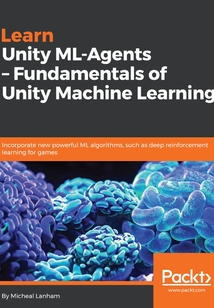首頁 > 計(jì)算機(jī)網(wǎng)絡(luò) >
數(shù)據(jù)庫
> Learn Unity ML-Agents:Fundamentals of Unity Machine Learning最新章節(jié)目錄
舉報(bào) 

會(huì)員
Learn Unity ML-Agents:Fundamentals of Unity Machine Learning
ThisbookisintendedfordeveloperswithaninterestinusingMachinelearningalgorithmstodevelopbettergamesandsimulationswithUnity.ThereaderwillberequiredtohaveaworkingknowledgeofC#andabasicunderstandingofPython.
目錄(116章)
倒序
- 封面
- Title Page
- Copyright and Credits
- Learn Unity ML - Agents - Fundamentals of Unity Machine Learning
- Dedication
- Packt Upsell
- Why subscribe?
- PacktPub.com
- Contributors
- About the author
- About the reviewers
- Packt is searching for authors like you
- Preface
- Who this book is for
- What this book covers
- To get the most out of this book
- Download the example code files
- Download the color images
- Conventions used
- Get in touch
- Reviews
- Introducing Machine Learning and ML-Agents
- Machine Learning
- Training models
- A Machine Learning example
- ML uses in gaming
- ML-Agents
- Running a sample
- Setting the agent Brain
- Creating an environment
- Renaming the scripts
- Academy Agent and Brain
- Setting up the Academy
- Setting up the Agent
- Setting up the Brain
- Exercises
- Summary
- The Bandit and Reinforcement Learning
- Reinforcement Learning
- Configuring the Agent
- Contextual bandits and state
- Building the contextual bandits
- Creating the ContextualDecision script
- Updating the Agent
- Exploration and exploitation
- Making decisions with SimpleDecision
- MDP and the Bellman equation
- Q-Learning and connected agents
- Looking at the Q-Learning ConnectedDecision script
- Exercises
- Summary
- Deep Reinforcement Learning with Python
- Installing Python and tools
- Installation
- Mac/Linux installation
- Windows installation
- Docker installation
- GPU installation
- Testing the install
- ML-Agents external brains
- Running the environment
- Neural network foundations
- But what does it do?
- Deep Q-learning
- Building the deep network
- Training the model
- Exploring the tensor
- Proximal policy optimization
- Implementing PPO
- Understanding training statistics with TensorBoard
- Exercises
- Summary
- Going Deeper with Deep Learning
- Agent training problems
- When training goes wrong
- Fixing sparse rewards
- Fixing the observation of state
- Convolutional neural networks
- Experience replay
- Building on experience
- Partial observability memory and recurrent networks
- Partial observability
- Memory and recurrent networks
- Asynchronous actor – critic training
- Multiple asynchronous agent training
- Exercises
- Summary
- Playing the Game
- Multi-agent environments
- Adversarial self-play
- Using internal brains
- Using trained brains internally
- Decisions and On-Demand Decision Making
- The Bouncing Banana
- Imitation learning
- Setting up a cloning behavior trainer
- Curriculum Learning
- Exercises
- Summary
- Terrarium Revisited – A Multi-Agent Ecosystem
- What was/is Terrarium?
- Building the Agent ecosystem
- Importing Unity assets
- Building the environment
- Basic Terrarium – Plants and Herbivores
- Herbivores to the rescue
- Building the herbivore
- Training the herbivore
- Carnivore: the hunter
- Building the carnivore
- Training the carnivore
- Next steps
- Exercises
- Summary
- Other Books You May Enjoy
- Leave a review - let other readers know what you think 更新時(shí)間:2021-08-13 15:58:44
推薦閱讀
- MySQL高可用解決方案:從主從復(fù)制到InnoDB Cluster架構(gòu)
- 云計(jì)算環(huán)境下的信息資源集成與服務(wù)
- Libgdx Cross/platform Game Development Cookbook
- Microsoft Power BI數(shù)據(jù)可視化與數(shù)據(jù)分析
- Spark大數(shù)據(jù)編程實(shí)用教程
- 智能數(shù)據(jù)時(shí)代:企業(yè)大數(shù)據(jù)戰(zhàn)略與實(shí)戰(zhàn)
- Starling Game Development Essentials
- Apache Kylin權(quán)威指南
- INSTANT Apple iBooks How-to
- HikariCP連接池實(shí)戰(zhàn)
- Hadoop集群與安全
- MySQL技術(shù)內(nèi)幕:SQL編程
- Unity 2018 By Example(Second Edition)
- 大數(shù)據(jù)技術(shù)體系詳解:原理、架構(gòu)與實(shí)踐
- 掌中寶:電腦綜合應(yīng)用技巧
- Nagios Core Administrators Cookbook
- XNA 4 3D Game Development by Example:Beginner's Guide
- 七周七數(shù)據(jù)庫
- Access 2010數(shù)據(jù)庫程序設(shè)計(jì)
- Deep Learning with Microsoft Cognitive Toolkit Quick Start Guide
- 數(shù)據(jù)自助服務(wù)實(shí)踐指南:數(shù)據(jù)開放與洞察提效
- DM8數(shù)據(jù)中心解決方案:達(dá)夢(mèng)實(shí)時(shí)同步工具
- 百度統(tǒng)計(jì):網(wǎng)站數(shù)據(jù)分析實(shí)戰(zhàn)
- 數(shù)據(jù)科學(xué)技術(shù):文本分析和知識(shí)圖譜
- 數(shù)據(jù)結(jié)構(gòu):使用C語言(第4版)
- 深度學(xué)習(xí)實(shí)踐:計(jì)算機(jī)視覺
- 游戲數(shù)據(jù)分析的藝術(shù)
- 數(shù)據(jù)可視化(第2版)
- 大數(shù)據(jù)走向云計(jì)算
- 臨危不懼:Oracle 11g數(shù)據(jù)庫恢復(fù)技術(shù)

